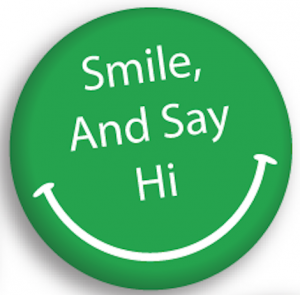
What can it do for you?
Connect you to others.
Release feel good chemicals in your brain.
Even fake smiling has been shown to reduce stress.
What can it do for others?
Help people feel welcome.
Increase a sense of trust.
Dispel concerns about possible hostility.
What can it do for your community?
Make communication easier.
Contribute to positive affect of the group.
Increase cooperation.
References
Kraft, Tara L. and Sarah D. Pressman. 2012. “Grin and Bear It.” Psychological Science 23(11): 1372 – 1378.
Allday, R. Allan and Kerri Pakurar. 2007. “Effects of Teacher Greetings on Student On-Task Behavior.” Journal of Applied Behavior Analysis Vol 40:2:317-320.
Abel E. and Kruger M. 2010. “Smile Intensity in Photographs Predicts Longevity.” Psychological Science 21: 542–544.
George, J.M. 1995. “Leader Positive Mood and Group Performance: The Case of Customer Service.” Journal of Applied Social Psychology 25: 778-794.
Mirivel, Julien C. 2014. The Art of Positive Communication: Theory and Practice. New York: Peter Lang Publishing, Inc.
Niedenthal, P., Mermillod, M., Maringer, M., & Hess, U. 2010. “The Simulation of Smiles
(SIMS) model: Embodied Simulation and the Meaning of Facial Expression.” Behavioral and Brain Sciences, 33: 417-433.
Centorrino, S., E. Djemai, A. Hopfensitz, M. Milinski & P. Seabright. 2015. “Honest Signaling in Trust Interactions: Smiles Rated as Genuine Induce Trust and Signal Higher Earning Opportunities.” Evolution and Human Behavior 36(1): 8-16.
